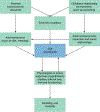Social and population health science approaches to understand the human microbiome
- PMID: 31457107
- PMCID: PMC6711373
- DOI: 10.1038/s41562-018-0452-y
Social and population health science approaches to understand the human microbiome
Abstract
The microbiome is now considered our 'second genome' with potentially comparable importance to the genome in determining human health. There is, however, a relatively limited understanding of the broader environmental factors, particularly social conditions, that shape variation in human microbial communities. Fulfilling the promise of microbiome research - particularly the microbiome's potential for modification - will require collaboration between biologists and social and population scientists. For life scientists, the plasticity and adaptiveness of the microbiome calls for an agenda to understand the sensitivity of the microbiome to broader social environments already known to be powerful predictors of morbidity and mortality. For social and population scientists, attention to the microbiome may help answer nagging questions about the underlying biological mechanisms that link social conditions to health. We outline key substantive and methodological advances that can be made if collaborations between social and population health scientists and life scientists are strategically pursued.
Figures

References
Publication types
MeSH terms
Grants and funding
LinkOut - more resources
Full Text Sources

